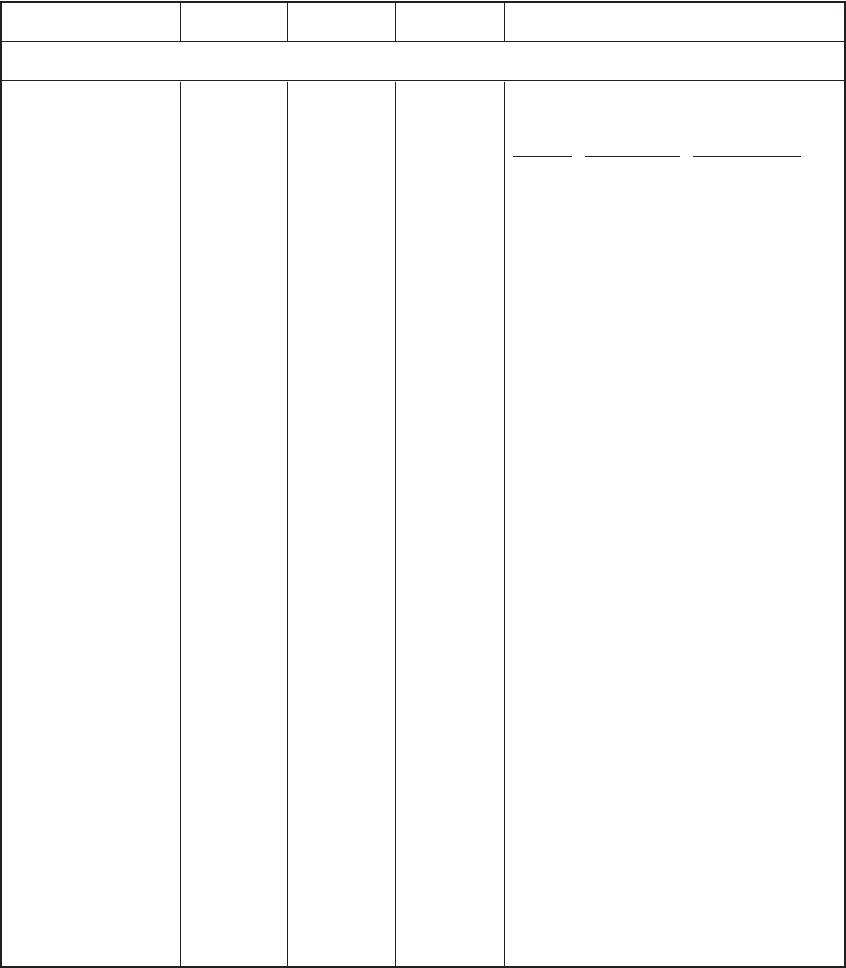
User's Guide
D-46 Code Sets
Table D-6. Epson and IBM Escape Sequences––continued
Function ASCII Hexadecimal Decimal Description
Graphic Functions––continued
Print IBM XL24 ................ ESC [ g n1 n2 1B 5B 67 n1 n2 27 91 103 n1 n2 Variable m in the sequences determines which graphics
graphics (continued) m list m list m list mode the printer uses:
Variable m
Mode Resolution ASCII Hex Dec
Single 72V x 60H dpi NUL 00 0
Double 72V x 120H dpi SOH 01 1
HS double 72V x 120H dpi STX 02 2
Quadruple 72V x 240H dpi ETX 03 3
Single 180V x 60H dpi BS 08 8
Double 180V x 120H dpi HT 09 9
Triple 180V x 180H dpi VT 0B 11
Hex 180V x 360H dpi FF 0C 12
In the HS double, quadruple and hex modes, consecutive
horizontal dots are not permitted. If the sequence
specifies consecutive horizontal dots, the printer does not
print the second dot.
The list in the sequence is a series of codes that define the
columns to print. Modes with 72 dots per vertical inch
print 8-dot-high columns. For these modes, the first code
defines the first column, the second code defines the sec-
ond column, and so on. Each bit in a code controls a
speci-fic dot in the column. The most significant bit
controls the top dot, the next bit controls the second dot,
and so on. If the bit is "1", the dot prints; if the bit is "0",
the dot does not print. For example, FF hex prints all
eight dots in the col-umn, 00 hex prints no dots, 0F hex
prints the lower four dots, and F0 hex prints the upper
four dots.
Modes with 180 dots per vertical inch print 24-dot-high-
columns. The first three codes define the first column, the
second three codes define the second column, and so on.
Each bit in a code controls a specific dot in the column.
The most significant bit of the first code controls the top
dot, the next bit controls the second dot, and so on. The
most significant bit of the second code controls the ninth
dot from the top, the next bit controls the tenth dot, and so
on. And finally, the most significant bit of the third code
controls the 17th dot from the top, the next bit controls the
18th dot, and so on. If the bit is "1", the dot prints; if the
bit is "0", the dot does not print. For example, FF FF FF
hex prints all 24 dots in the column, 00 00 00 hex prints
no dots, 00 FF 00 hex prints the middle eight dots, and 80
00 01 hex prints the top and bottom dots.
User's Guide
D-46 Code Sets
Table D-6. Epson and IBM Escape Sequences––continued
Function ASCII Hexadecimal Decimal Description
Graphic Functions––continued
Print IBM XL24 ................ ESC [ g n1 n2 1B 5B 67 n1 n2 27 91 103 n1 n2 Variable m in the sequences determines which graphics
graphics (continued) m list m list m list mode the printer uses:
Variable m
Mode Resolution ASCII Hex Dec
Single 72V x 60H dpi NUL 00 0
Double 72V x 120H dpi SOH 01 1
HS double 72V x 120H dpi STX 02 2
Quadruple 72V x 240H dpi ETX 03 3
Single 180V x 60H dpi BS 08 8
Double 180V x 120H dpi HT 09 9
Triple 180V x 180H dpi VT 0B 11
Hex 180V x 360H dpi FF 0C 12
In the HS double, quadruple and hex modes, consecutive
horizontal dots are not permitted. If the sequence
specifies consecutive horizontal dots, the printer does not
print the second dot.
The list in the sequence is a series of codes that define the
columns to print. Modes with 72 dots per vertical inch
print 8-dot-high columns. For these modes, the first code
defines the first column, the second code defines the sec-
ond column, and so on. Each bit in a code controls a
speci-fic dot in the column. The most significant bit
controls the top dot, the next bit controls the second dot,
and so on. If the bit is "1", the dot prints; if the bit is "0",
the dot does not print. For example, FF hex prints all
eight dots in the col-umn, 00 hex prints no dots, 0F hex
prints the lower four dots, and F0 hex prints the upper
four dots.
Modes with 180 dots per vertical inch print 24-dot-high-
columns. The first three codes define the first column, the
second three codes define the second column, and so on.
Each bit in a code controls a specific dot in the column.
The most significant bit of the first code controls the top
dot, the next bit controls the second dot, and so on. The
most significant bit of the second code controls the ninth
dot from the top, the next bit controls the tenth dot, and so
on. And finally, the most significant bit of the third code
controls the 17th dot from the top, the next bit controls the
18th dot, and so on. If the bit is "1", the dot prints; if the
bit is "0", the dot does not print. For example, FF FF FF
hex prints all 24 dots in the column, 00 00 00 hex prints
no dots, 00 FF 00 hex prints the middle eight dots, and 80
00 01 hex prints the top and bottom dots.


















